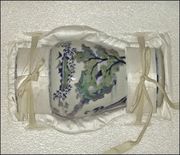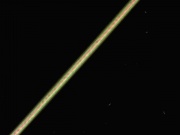Difference between revisions of "Ethafoam"
| Line 2: | Line 2: | ||
== Description == | == Description == | ||
| − | [Dow Chemical Company] A registered trademark for a | + | [Dow Chemical Company] A registered trademark Ethafoam is the brand name of polyethylene foam plank manufactured by Sealed Air Corporation (formally by Dow Chemical Company). It is a durable, flexible, closed-cell foam with excellent memory when used in an appropriate coverage and density for the load. It is watertight and impervious to most chemicals. It performs consistently through a wide range of temperatures. It is easily cut with knives, hot knives, band saws, powered foam rubber cutters, and table saws. Ethafoam adheres to itself and other polyethylene-based materials with heat-welding, or to most other surfaces with industrial-grade hot glue. The natural color of polyethylene foam is brilliant, sparkling white with a slight translucence in thin areas, but black and blue are also available in a limited range of sizes. Ethafoam is not cross-linked, so it is easily recyclable. |
| − | + | ||
| − | + | Sheets and planks have a skin on each of the large faces. The skin is an unbroken surface, but has a bubbly texture with approximately 1mm relief, and despite the absence of additives the foam feels waxy to the touch. The edges of the planks expose open cells where they have been broken. Individual cells range between 1-2mm diameter at medium density. Plank edges and other cut surfaces create a rougher texture than that of the closed skin. Both surfaces are generally considered too abrasive for making direct contact with sensitive surfaces, and require the mediation of a smoother material between the Ethafoam and the object, such as Tyvek Softwrap, Volara, or poly-sheeting for a few examples. This mediation can be achieved either by lining the foam or wrapping the object. | |
| + | |||
| + | Ethafoam 220 appears very similar to PolyPlank EXT220 and PolyPlank LAM220, another brand name of polyethylene foam, but the two PE foams are manufactured with slightly different methods and chemical compositions. PolyPlank has a larger cell structure on average, and the broken cell walls of cut surfaces feel rougher. It offers less resistance to compression and puncturing than Ethafoam of the same weight. PolyPlank LAM offers two more light-density options than Ethafoam; 0.9 pcf and 1.2 pcf. | ||
| + | |||
== Synonyms and Related Terms == | == Synonyms and Related Terms == | ||
| − | |||
| − | |||
== Applications == | == Applications == | ||
Revision as of 13:27, 23 November 2019
Description
[Dow Chemical Company] A registered trademark Ethafoam is the brand name of polyethylene foam plank manufactured by Sealed Air Corporation (formally by Dow Chemical Company). It is a durable, flexible, closed-cell foam with excellent memory when used in an appropriate coverage and density for the load. It is watertight and impervious to most chemicals. It performs consistently through a wide range of temperatures. It is easily cut with knives, hot knives, band saws, powered foam rubber cutters, and table saws. Ethafoam adheres to itself and other polyethylene-based materials with heat-welding, or to most other surfaces with industrial-grade hot glue. The natural color of polyethylene foam is brilliant, sparkling white with a slight translucence in thin areas, but black and blue are also available in a limited range of sizes. Ethafoam is not cross-linked, so it is easily recyclable.
Sheets and planks have a skin on each of the large faces. The skin is an unbroken surface, but has a bubbly texture with approximately 1mm relief, and despite the absence of additives the foam feels waxy to the touch. The edges of the planks expose open cells where they have been broken. Individual cells range between 1-2mm diameter at medium density. Plank edges and other cut surfaces create a rougher texture than that of the closed skin. Both surfaces are generally considered too abrasive for making direct contact with sensitive surfaces, and require the mediation of a smoother material between the Ethafoam and the object, such as Tyvek Softwrap, Volara, or poly-sheeting for a few examples. This mediation can be achieved either by lining the foam or wrapping the object.
Ethafoam 220 appears very similar to PolyPlank EXT220 and PolyPlank LAM220, another brand name of polyethylene foam, but the two PE foams are manufactured with slightly different methods and chemical compositions. PolyPlank has a larger cell structure on average, and the broken cell walls of cut surfaces feel rougher. It offers less resistance to compression and puncturing than Ethafoam of the same weight. PolyPlank LAM offers two more light-density options than Ethafoam; 0.9 pcf and 1.2 pcf.
Synonyms and Related Terms
Applications
- Lining cavities cut in foam
- Can be sewn and bonded with hot melt adhesives without melting
Personal Risks
Nomex SDS [[1]]
Environmental Risks
Collection Risks
May be susceptible to snagging on corners.
Physical and Chemical Properties
Resistant to acids, alkalis, bleaches and most solvents. Fiber is smooth. Permeable to air and moisture. Fiber cross section = dogbone. Fire resistant and self-extinguishing. Degrades in ultraviolet light.
| Melting Point | 370 |
|---|---|
| Density | 1.38 |
| Tenactiy | 5.3 g/denier (dry) |
| Elongation | 22% |
| Moisture regain | 3.5% |
Working Properties
The spunwoven version of Nomex is typically used in museum applications. It has the unique ability to stretch in one direction, preventing bunching and folding of loose material within a cavity (PACCIN).
Forms/Sizes
Forms include fibers, paper/fabric, felts, and rigid honeycomb boards. Flexible fabric typically comes rolls with widths of 39”. Thicknesses range from 3 to 30 mils.

